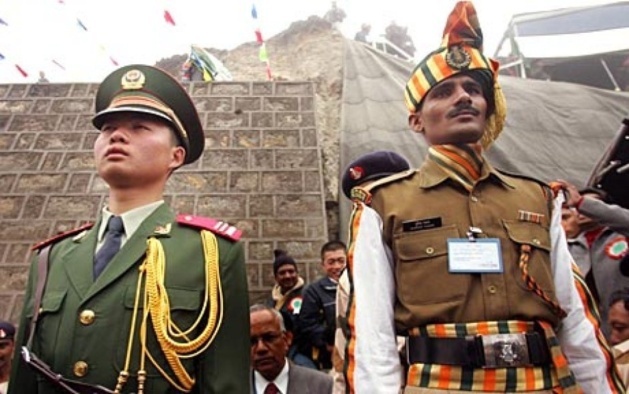
Meeting between Chinese and Indian troops, after the strains of last April 15th. Credits: File Pics
It all began during the night of April 15th. About thirty Chinese soldiers crossed the border and established a camp more than 15 kilometers away from there in the Indian land. The troops have been staying nearly a month in that mountainous, uninhabited and hostile region of the Ladakh. The message from Beijing is clear: the surrounding 90,000 km² are its property. There is no question of approving the colonial boundaries established by the British in 1914. Tension is rising; the fear of a military escalation between the two nuclear-weapon States is becoming increasingly palpable.
A month later, it seems that the tension has declined. “Our bilateral relations are based on peace and order at the border thus, any perturbation would have an impact on our relationship”, declared the Indian Prime Minister Manmohan Singh along with his Chinese counterpart Li Keqiang, last May 20th.
But at the end, the Indian Minister of Defense is about to deploy a force of 40,000 soldiers along this part of the border.
A month later, it seems that the tension has declined. “Our bilateral relations are based on peace and order at the border thus, any perturbation would have an impact on our relationship”, declared the Indian Prime Minister Manmohan Singh along with his Chinese counterpart Li Keqiang, last May 20th.
But at the end, the Indian Minister of Defense is about to deploy a force of 40,000 soldiers along this part of the border.
Fifty years later
This is not the first time that China and India are fighting for that piece of land. Both the countries had engaged in a month-long war in 1962 to control this Himalayan region. Before they declared a unilateral ceasefire agreement, the Indian troops experienced widespread loss of lives due to the Chinese forces.
Since then, the two countries are regularly accusing each other of incursion. As the Indian Chief of Staff, Vikram Singh, explained, on both sides of the border, the soldiers are patrolling without knowing how far their respective nation goes.
On Chinese maps, the disputed region is named “Southern Tibet”. So why would Beijing have an interest in a land where, after all – as former Indian Prime Minister Jawaharlal Nehru said – “even grass will not survive”? “Whether that piece of land is inhospitable or not, nothing changes for Beijing. The only thing that is important is to know if China considers that land as its own or not”, explains D.S. Rajan, director at the Chennai Center for China Studies. However, according to Lora Saalman, from the Carnegie Foundation for International Peace, “it is rather because the Chinese government is worried about the Indian activity in the region, where new roads and landing runways have recently been built”.
Since then, the two countries are regularly accusing each other of incursion. As the Indian Chief of Staff, Vikram Singh, explained, on both sides of the border, the soldiers are patrolling without knowing how far their respective nation goes.
On Chinese maps, the disputed region is named “Southern Tibet”. So why would Beijing have an interest in a land where, after all – as former Indian Prime Minister Jawaharlal Nehru said – “even grass will not survive”? “Whether that piece of land is inhospitable or not, nothing changes for Beijing. The only thing that is important is to know if China considers that land as its own or not”, explains D.S. Rajan, director at the Chennai Center for China Studies. However, according to Lora Saalman, from the Carnegie Foundation for International Peace, “it is rather because the Chinese government is worried about the Indian activity in the region, where new roads and landing runways have recently been built”.
Expansionist aims from China
India is not the only country to be exposed to Chinese expansionism which also affects Japan, South Korea, Vietnam and Philippines. But when China is aggressive at the Sino Indian border, India plays along. “As they do, we also get into areas that are under Chinese sovereignty”, reminds Srinath Raghamon - from the Center for political studies of New Delhi - to the South China Morning Post. “These incursions will last until there is a common ground on the border.” Dr. Li Mingjiang, professor at the international study Institute S. Rajaratnam in Singapore, added that Chinese ambitions reflect the renewal in Beijing, when president Xi Jinping intends to mobilize the whole country to defend its territorial integrity.
China is already the main economic partner of India. The bilateral trade between the two countries increased from three billion US dollars in 2000 to eighty billion in 2012. However, Beijing’s hostile attitude along the Western border could harm the relations between the two countries and encourage the Indians to turn to the United States, what frightens the Chinese government. And Delhi does not intend to let China lead it around by the nose.
China is already the main economic partner of India. The bilateral trade between the two countries increased from three billion US dollars in 2000 to eighty billion in 2012. However, Beijing’s hostile attitude along the Western border could harm the relations between the two countries and encourage the Indians to turn to the United States, what frightens the Chinese government. And Delhi does not intend to let China lead it around by the nose.



























